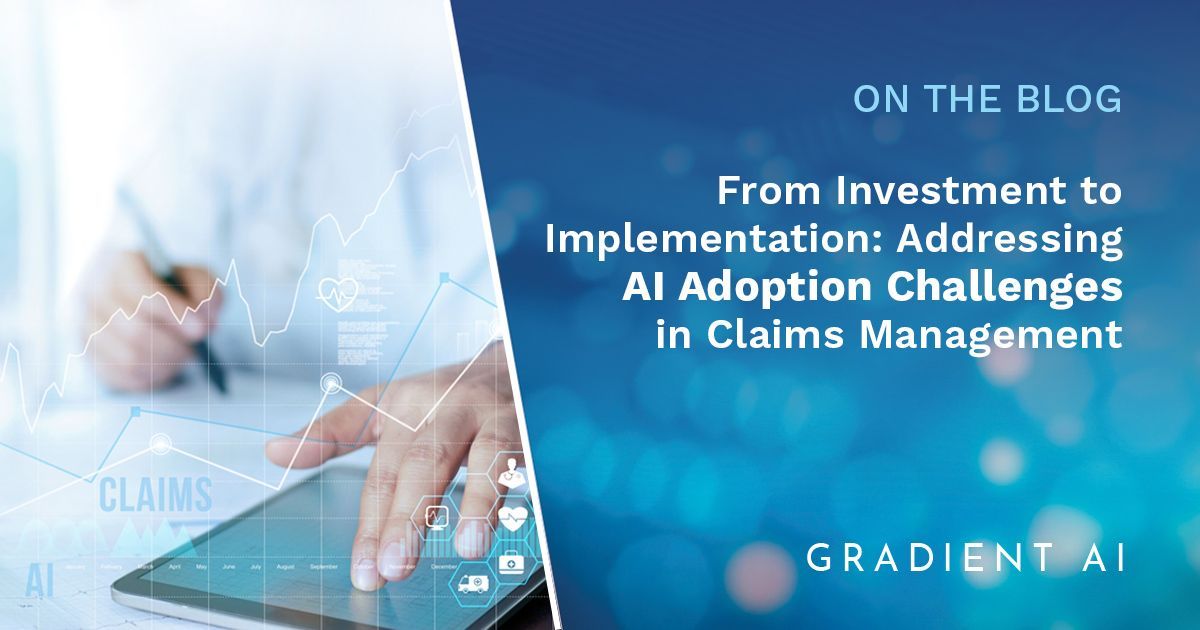From Investment to Implementation: Addressing AI Adoption Challenges in Claims Management
AI in Claims Management: New Study Reveals a Disconnect Between Investment and Impact
As the property and casualty insurance industry continues to invest heavily in AI, many insurers are still struggling to achieve meaningful results at the operational level — especially in claims. A new research study by Elevate the Narrative titled “From the Front Lines: Claims Adjusters Speak Out,”1 exposes a critical gap between insurance executives’ AI ambitions and claims adjusters’ AI usage in day-to-day claims management.
With input from over 1,000 professionals, the report highlights the key challenges and opportunities for insurers seeking to transform their claims operations through AI.
3 Key Findings from the Study: A Candid Look into the Claims Front Lines
The study reveals that while technological investment is on the rise, many claims adjusters remain overwhelmed, under-supported, and disconnected from the tools designed to help them. In this blog post, we summarize 3 key findings from the study, and then suggest ways to address the challenges.
1.
Lack of training:
58% say they lack support on new technology, including inadequate training
Frontline claims professionals are expected to adapt quickly to new technology, yet many report receiving little guidance or structured training to support that transition. This gap leaves adjusters feeling unprepared and undervalued, hindering adoption. As AI-driven tools continue to enter the workflow, a proactive approach to training is no longer optional; it’s essential to performance and retention.
Takeaway: These barriers must be addressed to unlock the full potential of AI and digital transformation. Following a successful AI implementation with a client-focused partner, insurers should view training not as a one-time event, but as an ongoing investment in workforce capability. That means offering continuous learning opportunities, practical job-based scenarios, and support channels that reinforce adoption over time.
2. Confidence gap: 58% report low confidence in using their AI tools effectively
The point is closely related to #1 above. The study showed that while 40% of respondents are currently using AI tools for claims processing, a majority report not feeling confident about using the new tools.
Takeaway: There’s a clear disconnect between AI implementation strategies and real-world usage. Insurers must partner with solution providers that deliver AI solutions featuring model explainability, rather than a “black box.” Additionally, insurers need to design and deliver training that builds staff confidence. Confidence directly impacts adoption, efficiency, and overall success of any change initiative. When stakeholders feel capable and comfortable using new technology that they can understand, they’re more likely to embrace the change and apply what they’ve learned effectively.2
3. Technology frustrations: 65% cite lack of integration between systems
Pain points in the study included lack of, or redundant documentation and outdated platforms that complicate workflows.
Takeaway: Legacy systems and siloed data continue to undermine efficiency and increase friction - further complicating AI rollout efforts. When claims professionals are forced to toggle between multiple platforms or manually input data, it slows productivity and creates opportunities for errors. Insurers must take integration seriously, investing in modern, interoperable solutions that unify the claims ecosystem and provide AI-enablement at the point of decision.
The Path Forward: Align AI Strategy with Claims Frontline Reality, Supported by a Robust Change Management Program
Research shows that for people and process changes to be successful, organizations must prepare, equip, and support their staff, so that they successfully adopt the changes.3
To bridge the gap between AI investments and practical results, insurers must:
- Invest in AI training and onboarding tailored to adjusters' roles
- Streamline workflows by modernizing core systems, providing their teams with access to understandable solutions that support their work
- Establish a robust change management program
A structured, robust change management program is essential to guide this transformation. A recent study found that 88% of companies with excellent change management programs exceeded expectations, compared to only 13% of those with poor change management programs. As well, effective change management programs reduce common project headaches, such as rework, redesign, and rescoping.4
To help insurers address the people and process challenges that can come with implementing new AI solutions into your claims management operations, Gradient AI has developed a practical framework and checklist for change management success, called 6 Change Management Steps for Successful Adoption of New Technology, such as AI, in Insurance.
This guide outlines practical steps such as:
- Pre-planning with the right change agents and communication tools
- Conducting a training needs assessment to design role-specific, just-in-time learning
- Using stakeholder mapping and feedback loops to tailor communications
- Continuously measuring readiness and reinforcing adoption post-launch
These best practices are not just theory — they reflect lessons learned from insurers that have navigated the same adoption challenges you face today. For P&C insurers committed to achieving true operational impact from their AI investments, this guide is a must-read.
- Elevate the Narrative, From the Front Lines: Claims Adjusters Speak Out, 2025.
- Whatfix, Change Management Training in the Workplace, January 16, 2025.
- Prosci, What is Change Management, 2025.
- Prosci, The Correlation Between Change Management and Project Success, July 31, 2024.


